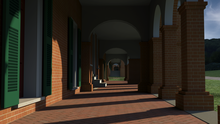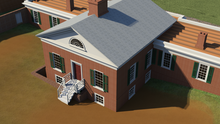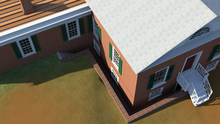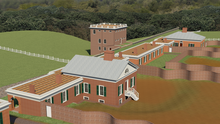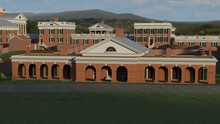Hotel C is the center hotel of the three hotels on West Range, which were built between 1820 and 1822.[1] It cost a total of $16,897.78 for the construction of the six hotels, including $4,525.38 for Hotel C. [2] In Jefferson’s earliest plans, when conceiving of Albemarle Academy and later Central College, he gave no thought to having East and West Ranges. Jefferson first designed the pavilions, which were derived from books by classical architects such as Andrea Palladio and Roland Fréart de Chambray. Then he sent letters to architects Benjamin Latrobe and William Thorton, who both suggested adding some type of building to the north, where the Rotunda now exists, to close the quadrangle. Latrobe sent Jefferson a large roll of drawings and asserted that there should be a building larger than the pavilions. “Later, in 1817, the central college was reorganized as The University of Virginia, and 153 acres of land was purchased. Jefferson’s original scheme of two rows of buildings was then split into four rows in order to better adhere to the site.” [3] The greatest challenge in this reconstruction was the settlement of the first hotel in 1820. Jefferson decided to place the hotel in a new row parallel to the pavilions instead of extending the rows of pavilions. That decided the square shape of the University.
The hotels were used as boarding houses for faculty and students at the beginning, but over time they were repurposed for things like literary societies and social events. Hotel C was first constructed as a dining hall in 1820. Soon after, the Washington Society, founded in 1835, convened there. In 1837, when the Washington Society moved from Hotel C to Pavilion VII, the Jefferson Society was granted possession of the large room in the hotel and it still resides in Hotel C now. In 1841, the Society was authorized to make alternative changes in the shape or the partitions in Hotel C.
The Jefferson Society was formed on July 14, 1825 when its first meeting was held on West Lawn. It was built by students who broke away from the Patrick Henry Society because of its disorderly meetings. The aim of the new society was to “provide for our common improvement in those around us, and drill ourselves in all the exercises which strengthen for the free duties of citizenship.”[4] The society contributed to outdoor activities and events such as the memorial stone for the Washington Monument in 1848. The Jefferson Society started with a literary society but after the civil war, it turned into a political one.[5] In 1895, the society concentrated in forensics and took part in debate leagues. The society survived through the Civil War, political and factional activity, and became the largest literary society in the United States in 1982. In 1913, the Jefferson and Washington Societies proposed establishing a debating league among high schools in Virginia. This contributed to the Virginia Literary and Athletic League. The Jefferson Society was consistently victorious when participating in basketball and football. The University of Virginia Magazine was revived by the society in 1956.
See also: Hotel C Photograph Gallery
[1] Pictorial History of the University of Virginia, 1968, Rector and Visitors, University of Virginia.
[2] Hotel C, West Range, University of Virginia, 1984, Messrs. Jerry Carrier and Michael Stewart, under the direction of Prof. K. Edward Lay, University of Virginia.
[3] IBID, 3
[4] IBID, 7
[5] Moore’s history, 1959, Mr. John M. Moore, https://jeffersonsociety.org/moores-history/
|
Hotel C Arcade |
Hotel C Porch |
Hotel C: Back Aerial |
|
Hotel C South Facade |
Hotel C at twilight |
Hotel C Northwest Facade |
